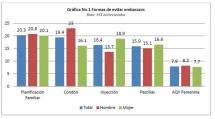Evaluation of the Family Planning and Law Campaign
An Ad Trac study was implemented to evaluate the communication campaign of the Family Planning Law, in May 2014. The sample was representative from men and women between 18 – 49 years old, living in the prioritized departments where USAID|PlanFam project implemented activities. It was a quantitative and descriptive study, and the sample was estimated based on the total population of men and women in the selected municipalities, using population projections for 2014 from the National Statistics Institute (INE), defining a confidence level of 95%, interval 5%, and a total of 384 interviews (49% men and 51% women).
The questionnaire included mixed questions (open and closed), to make face to face interviews, and the study evaluated the recall of messages to inform and disseminate messages about the Guatemalan Family Planning Law, also collecting information about the different channels used.
Main results include the following data:
Knowledge about the FP Law:
- A 14.9% from total interviewed persons, answered that they know about the FP law (graphic No. 2). The most frequent concept they recall about the law is “i have the right to plan my family”. The main concepts recalled are:
- I have the right to plan my family, 31.9%
- Women are in risk when there are many pregnancies or not well spaced, 14.7%
- Women´s lives are at risk when pregnancy is unplanned (too young or too old) 14.7%
Channels to learn about the FP Law (spontaneous recall):
- About the channel to learn about the FP law, most persons learned about it at the Health Center 49.4% (41 persons), while a 15.7% (13 persons) learned about it from the radio (table No.4).
- Assisted recall: (images showned by interviewer)
- 21.3% recalled the image among a series of images, indicated it was about (table No. 6): the family planning law (18.5%), family planning (43.5%), rights to plan the family (13.9%), have a healthy and happy family (24.1%).
Evaluation of each material:
- Audio channel: 34.8% listened at least one spot (base of 164 persons). From this, a 60.3% listed the spot in the radio, the rest in other channels (health fairs, kiosks, etc). A 84.2% of persons that listened a spot recall the key messages (table no. 7).
- Video channel: A 16.5% saw a video (base of 164 persons). From this, a 44.8% saw the video at the health service. A 92.6% recall the key messages of the video (table No.8).
- Pamphlet, printed material: A 32.3% saw at least a pamphlet, (base of 164 persons), from this a 59.4% saw it at the health service, a 4.7% saw it with a community health worker of PlanFam project. A 71.7% recall the key messages of the material (Table No.9).
- Comics book, printed material: A 16.5% was exposed to this material (base of 164 persons), from this a 60 % saw it at the health service and a 16.7% saw it at a school facility. A 63% recall the key messages (table No.10).:
- Poster, printed material: the poster was the channel the population was most exposed to with a 73.2% (base of 164 persons). The health service was the most effective place to see the material with a 72.5%, then on the street a 9.2% and at a school facility a 7%. A 80.8% of persons recall the key messages (tabla No.11).
- Flipchart, printed material: Only an 8.5% recall to have seen the flipchart, (base of 164 persons), from this a 50% saw it at the health service, an 11% saw it at a FP clinic, al 5.6% with a community health worker of PlanFam project. A 64% exposed to the material, recall the key messages included in it (tabla No.12).
Main conclusions:
- Posters were the most effective channel to recall the messages (the human right to family planning).
- Radio is the second most effective channel to disseminate the messages, with a 14.8% (base of 397 interviewed persons).
- Most of the persons exposed to the campaign recall the key messages and refer to the human right to family plan.
- All persons exposed to different materials in different channels (100%) indicated they liked the materials, and what they liked the most was the message about family planning.
Source: Ministry of Health Guatemala, PASMO, PSI
Date of Publication: March 25, 2019
SIMILIAR RESOURCES
Tools
Examples
- Social Franchising: Improving Quality and Expanding Contraceptive Choice in the Private Sector
- Early Impacts of the COVID-19 Pandemic: Findings from the 2020 Guttmacher Survey of Reproductive Health Experiences
- Opportunities for Postpartum Family Planning in the Private Sector
- “Because my Husband and I Have Never Had a Baby Before…” Results and Lessons from Interventions with First-Time Parents in Madagascar, Mozambique, and Nigeria
- SBCC for Malaria in Pregnancy: Strategy Development Guidance
- How Businesses Can Invest in Women and Realize Returns
- La Planification Familiale dans les Situations d'Urgence: Essentielle,, Voulue, Necessaire et Realisable
- Lessons Learned from an Integrated Approach for Reaching First-time Young Parents in Nigeria
- Evidence to Inform Social and Behavior Change for Family Planning in Francophone West Africa
- Using Social & Behavior Change To Improve Family Planning Outcomes / Utilisation du Changement Social et Comportemental pour Améliorer le Bilan du Planning Familial en Afrique de l'Ouest

